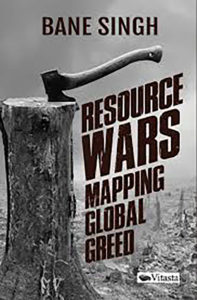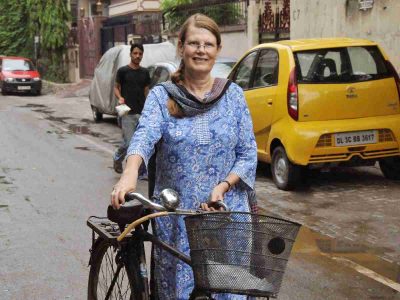With every country competing to exploit scarce natural resources, a time will come when humanity as a whole pays the price for our mindless pursuit of profit, writes ecologist Bane Singh in his new book
Environmentalist Bane Singh has recently come up with his latest book, Resource Wars: Mapping Global Greed, an overview of earth’s resources and an insight on the detrimental impact of fatal exploitation of resources. The book sheds light on the global competition for the Earth’s natural resources as in the last five decades resource extraction has tripled. The book opens our eyes to the fact that in the fight for limited resources, technology is a key determinant of winners and losers among nations fighting for non-renewable resources like oil, uranium and even renewable resources: the sun, sea and sand.
Civil engineer turned ecologist Bane Singh has earlier worked in the field of water management for over two decades. He was associated with the National Mission for Clean Ganga and authored three earlier books on ecology. He has been associated with numerous reports during his professional career. Patriot spoke with him to understand global war on resources and market for environmental writing.
Q: Your Dedication in the book reads, “To Mother Earth, with due apologies”. Since you have written three books on the environment before, can you explain when you first felt concern about overexploitation of the planet’s resources?
A: I was primed for the environmental and ecological concerns of the planet in the early 1990s. I first thought of systematically compiling and writing about the more conspicuous global environmental concerns (climate change, global warming et al) of the time. Healing the Blue Planet was written during 2005-2011. Side by side, by the dawn of this century, concerns over over-exploitation of Natural Resources started coming to the fore and after finishing the maiden book, I immediately commenced writing about the book in 2012.

Q: Although fracking in the US reduced that country’s dependence on the Middle East’s petroleum, you seem to indicate that extraction of shale gas is no longer sustainable. Did I understand that correctly?
A: Shale Gas production in the US has dramatically increased after 2010. It was below 10 bcft (billion cubic feet) /day during 2000-2008 which tripled to 30 bcft/day in 2013 and reached 70 bcft /day in 2019. Gas was available rather cheap in the US. But fracking comes with lots of environmental issues. After the recent pandemic, the global energy demand has dropped off the cliff and global oil prices have nosedived. As a result, a new bankruptcy filing from shale gas companies has been arising virtually every week or so during the past couple of months. In June 2020, the US’ second-biggest gas producer Chesapeake filed for chapter 11 protection.
More pain would be witnessed until energy demand pulls on. Cost cutting, efficiency improvement and environmental responsible extraction are direly needed on the part of shale gas companies.
Q: Your book tells us that in Southeast Asia, sand is even smuggled across borders. Is there no substitute for sand in future construction?
A: Illegal sand mining is well documented in at least five dozen countries including Cambodia, Lao PDR, and Vietnam in South-East Asia. The main issue is even if the legal contract is awarded, sand miners tend to draw excess sand than what is stipulated in the contract. In many countries, there is close nexus between the corrupt politicians and sand mafia.
M-sand (manufactured sand), CBA (coal bottom ash), copper slag, FS (foundry sand), GBFS (granular blast furnace slag) , CWG (crushed waste glass), QRD (quarry rock dust) and C&DW (construction & demolition waste) tend to constitute viable alternatives to sand.
Q: You started your career working in the field of water management. Do you see a bigger scope for sea water to be used to solve problems of water scarcity? If not, why not?
A: Desalination of sea water isn’t a silver bullet and at the same time I’m not a great advocate of the desalination process itself. The process is prohibitively expensive and energy intensive. On an average, it requires around 15,000 kw-hours of power for every million gallons of fresh water produced. Besides, it is a highly environmentally damaging process. It could be used by some coastal countries out of compulsion and where energy inputs are rather cheaper. Moreover, disposal of concentrated waste emanating from the process poses a real threat! In the Indian context, conservation and recycling programmes are better options and much cheaper than DSPs.
Q5: As you know, Indian cities like Delhi are also running out of ground water. What possible ways do you suggest to solve the mammoth water needs of these cities?
A: Things are quite worrisome and scary on the water front for the city of Delhi. On the one hand, scarce rainfall year after year tends to fill one with gloom and doom; on the other hand depleting GWT (ground water table) depicts a sinister picture! Rainfall pattern has deteriorated, Delhi has been receiving deficient rainfall since 2014 from the LTA (long term average) of 648.9 mm (leaving only 2017-18) this is accompanied with the heavy GW withdrawal of 90 MGD; hence sufficient ground water recharge has not been taking place and GWT is depleting at a drastic rate of 10 cm /year.
However, technological advancements and simpler technologies like RWH (rain water harvesting) may offer plausible and viable solutions. Massive water conservation, recycling and harvesting works are needed for Delhi. NRW (non-revenue water) needs to be arrested, advanced technologies for minimising T&D (transmission & distribution) losses to be deployed viz DDD (demand driven distribution), EPS (equated pressure supply), LMS (leak monitoring system) and hydrophones for trunk mains & DMA (district metering areas).
The entire amount of treated waste water from WwTF (wastewater treatment facility) ought to be fully utilised. Existing STPs either need to be upgraded or capacity enhanced. Bioremediation/Phytoremediation of all nullahs be undertaken on war footing. Large scale Aquifer recharge works are also warranted.
Q: It was surprising to read that coal energy will continue to be a big contributor to future energy needs. Indian government also allowed over 40 coal mines for commercial mining. That means developing countries are still looking for heavy reliance on coal energy. How long will the world’s coal resources last?
A: The global coal production has nearly doubled since 1990. Currently around 7800 bt (billion ton) is produced worldwide. The US has substantially reduced production but China has doubled its production since 2000. Though enough coal reserves are there worldwide that might last 150 years or so, but the reliance on coal needs to be gradually reduced in order to save the planet!
Q: Why do you think the world is still stuck on coal? Can we afford such a heavy reliance on coal considering the threat that it is posing to the environment?
A: In many countries, coal still constitutes a cheaper source of energy hence greater reliance upon it. One tonne of coal burnt produces nearly 2.4 tonnes of CO2; hence reduction of this high volume through CCTs (clean coal technologies) is paramount.
Q: Lastly, what impact do you feel writing about the environment has on planners and the general public? In other words, is there a big enough market for such books?
A: Writing a book of this kind consumes much time, energy and resources hence such books are rarely brought out! Globally, especially in the western world sustainable living, environmentalism, protection of natural resources are rapidly catching the fancy of the masses. People there collect and read with massive interest books on Earth and environment. In India, though the awareness level is not that high but readers are gradually following suit! Such books nevertheless tend to form mass opinion & elevate awareness level across the continents.





